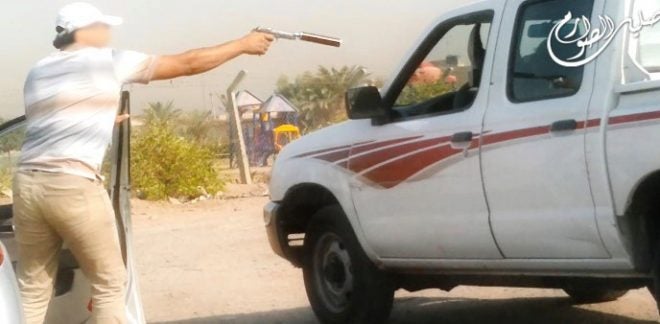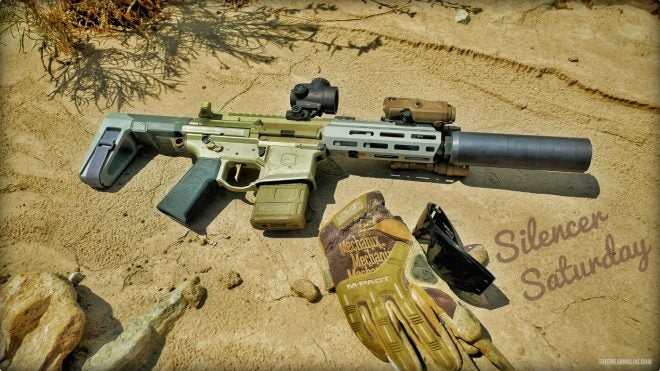Hello everyone and welcome back to TFB’s Silencer Saturday. Although I have shot the Q Honey Badger chambered in 300 Blackout every day and almost every night for the past week, I thought I’d give you all a break from my new romance with thirty cal kurz (band name, I call it). Listening to me gush about 300BLK is probably akin to that friend back in high school that “discovered” Led Zeppelin years after everyone was already sick of Stairway To Heaven and only listened to the deep tracks while smoking cloves and drinking Keystone Light. Anyway, next week we return with metering and shockingly, a suppressed K-sized Pistol Caliber Carbine. This week I’d like to open up a discussion about the potential for a set of universally accepted Suppressor Evaluation Standards that could implemented industry-wide.
Title Image: Q, LLC’s Honey Badger with the Trash Panda Silencer From Silencer Shop
SILENCER SATURDAY #29: Suppressor Evaluation Standards
Here’s the theory: In the future, every silencer sold in the U.S. would include a label that resembles a modern-day nutritional label found on food products. However, instead of calories per serving, grams of sugar, ingredients and daily recommended values, each label would contain variables important to any potential owner of a particular silencer.

Part of me hates boiling things down to a handful of numbers for quick digestion. Buyers should be responsible enough to put the time into their own research when making a ~$1,000 investment. However, something has to change: current thousands of silencer buyers rely on catchy, high-res advertising, hearsay, world of mouth and crowd-sourced data that may have nothing to do with actual silencer performance. Specifications as simple as overall weight have been reported inaccurately in some manufacturers official printed documentation.
For a Suppressor Evaluation Standard (SES) to become a reality, a few things have to happen:
- The adoption/creation of an organization that would help guide manufacturers and their products towards “compliance”. This organization would be comprised primarily of industry leaders from manufacturers, distributors and dealers but would also include independent members. Maybe this organization should be the American Suppressor Association (ASA). Maybe a new organization needs to be created. The head of the organization should either be an independent party or rotated every few years between major manufacturers
- Independent testing standards that are universally accepted by manufacturers. This will be contentious and will take time but will be an important part of the process.
- Free testing of products to manufacturers who are members of the organization. Membership dues would fund the independent tests and would include a set number of products for every calendar year.
- Categories for the SES that would be agreed upon by member organizations. The categories should be easy to understand by the general consumer and have real-world value. Obviously, weight, materials, calibers and ratings, coatings are important. But decibel readings should also be included. The MIL-STD testing has been used for years and I still believe it has value. There are still a large number of shooters who do most of their suppressed shooting at outdoor ranges where the MIL-STD value may still be useful. However, it should be supplemented with an At-Ear or modified At-Ear value. Other factors like flash suppression should also be considered
- Voluntary participation. I don’t believe that forcing industry into regulations is a way to get better products. However, if consumers started demanding fairness and equality from a universally accepted evaluation standard, eventually all manufacturers would realize that submitting products for testing is a good idea.
We can argue all we want about what should be included in the Suppressor Evaluation Standards – and we should give it a proper debate. But arguing against uniform testing and truth in advertising is unacceptable. We should have had a standardized protocol and method of reporting data to consumers years ago.
I’m looking forward to hearing your thoughts and ideas on the SES program. See you next week
TFB’s Silencer Saturday is brought to you by Sig Sauer
Vic Nighthorse’s Suppressed .338 Spectre


My .338 Specter as pictured with 15 300gr rounds in the mag and one in the chamber is 9lbs. It is really handy feeling until I put on the suppressor and insert the mag, then it is not.
I never added up how much it cost because it would probably make me puke.
It is hard for me to be accurate with the MRO because I have an astigmatism and the dot looks like an asymmetrical starburst roughly 6MOA x 3MOA in size though the bright center (also not symmetrical) may be only 2MOA x 1MOA. The blue green tint also annoys me even though it doesn’t effect use.
The bullets are 300 and 165 Makers retrieved from a 20” block of clear ballistic gel. All went about 19” and pretty straight. The 165s had a MV of about 1782fps and the 300s about 1000fps.
Perhaps due to the gas blocking charging handle don’t notice any gas what so ever in my face.
I like the sling, but then again the only other ones I ever used were Army issue in the ‘80s and ‘90s. I don’t remember those but very vaguely.
- 2A Armament Balios Lite receiver set
- Southern Ballistics Research 10.5″ stainless barrel (tapered mounting surface machined per Sig’s instructions)
- BCM KRM 9″
- AR Performance 6.8 NI3 Superbolt
- JP Enterprises Silent Captured Spring
- Cryptic Coatings Mystic Black bolt carrier
- Sentry 7 adjustable gas block
- Geissele SSA-E trigger
- Badger Ordnance Enhanced Bolt Catch
- Battle Arms Ambidextrous Safety Selector
- Seekins Precision Billet Magazine Release Button
- Battle Arms Enhanced Pin Set
- Spikes Tactical melonite carbine gas tube
- Strike Industries Ultimate Dust Cover
- ERGO Tactical Deluxe Sure Grip Pistol Grip FDE
- Norgon Ambi-Catch mag release
- Andy’s Leather Ching Sling
- Midwest Industries QD sling swivels and mounts
- Armageddon GMS-15 Charging Handle
- Magpul MOE Fixed Carbine Stock
- Sig SRD338TI-QD suppressor
- PRI Stainless 6.8 mags (heavy)
- Trijicon MRO
- Case catcher and mount

KEEPING IT QUIET – SUPPRESSOR USE BY JIHADIS, MILITANTS & MORE
https://www.calibreobscura.com/jihadi-rebel-and-militants-use-of-supressors/
Amongst various militant groups in the Middle East there is a sporadic yet noteworthy use of suppressors used on firearms. I’ve been tracking this and have found that suppressors, also known as silencers or moderators, have been used by Hayat Tahir al-Sham (HTS), Islamic State (ISIS), People’s Protection Units (YPG), and some other groups. This has lead to some interesting conclusions from my observations. Whilst there doesn’t seem to be a great dearth of video or still imagery of suppressor use by any major rebel group in Syria, in this article I’ll be looking at analysing some of them. – READ MORE – CalibreObscura.com
Thanks to TFB’s Miles V. for the source article.

SIG Sauer Silencers: The SRD556-QD & SRD338TI-QD
https://www.somarriba.com/single-post/2018/06/16/SIG-Sauer-Silencers
 Your Privacy Choices
Your Privacy Choices

